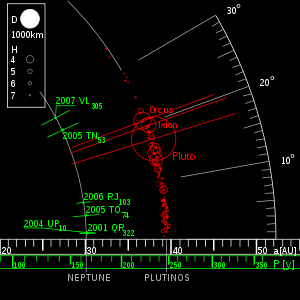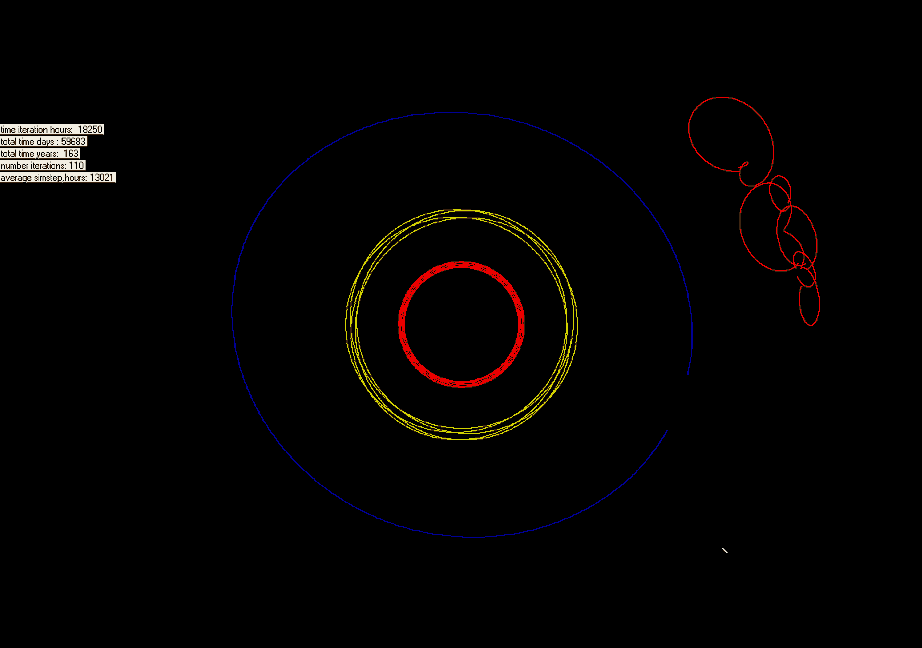
Neptune Trojan
Encyclopedia

Trojan (astronomy)
In astronomy, a Trojan is a minor planet or natural satellite that shares an orbit with a larger planet or moon, but does not collide with it because it orbits around one of the two Lagrangian points of stability , and , which lie approximately 60° ahead of and behind the larger body,...
(named by analogy to Jupiter's Trojan asteroids) are Kuiper belt object
Kuiper belt
The Kuiper belt , sometimes called the Edgeworth–Kuiper belt, is a region of the Solar System beyond the planets extending from the orbit of Neptune to approximately 50 AU from the Sun. It is similar to the asteroid belt, although it is far larger—20 times as wide and 20 to 200 times as massive...
-like bodies in solar orbit that have the same orbital period as Neptune
Neptune
Neptune is the eighth and farthest planet from the Sun in the Solar System. Named for the Roman god of the sea, it is the fourth-largest planet by diameter and the third largest by mass. Neptune is 17 times the mass of Earth and is slightly more massive than its near-twin Uranus, which is 15 times...
and follow roughly the same orbital path. Six of the eight found so far lie in the elongated, curved region around the Sun
Sun
The Sun is the star at the center of the Solar System. It is almost perfectly spherical and consists of hot plasma interwoven with magnetic fields...
–Neptune
Neptune
Neptune is the eighth and farthest planet from the Sun in the Solar System. Named for the Roman god of the sea, it is the fourth-largest planet by diameter and the third largest by mass. Neptune is 17 times the mass of Earth and is slightly more massive than its near-twin Uranus, which is 15 times...
Lagrangian point
Lagrangian point
The Lagrangian points are the five positions in an orbital configuration where a small object affected only by gravity can theoretically be stationary relative to two larger objects...
60° ahead of Neptune.

Order of magnitude
An order of magnitude is the class of scale or magnitude of any amount, where each class contains values of a fixed ratio to the class preceding it. In its most common usage, the amount being scaled is 10 and the scale is the exponent being applied to this amount...
.
Both and were believed to be Neptune trojans when first discovered, but were later reclassified.
On August 12, 2010, the Minor Planet Center announced the discovery of the first known Neptune trojan, . Neptune's trailing L5 region is currently very difficult to observe because it is along the line-of-sight to the center of our galaxy, an area of the sky crowded with stars.
It may be possible for the New Horizons
New Horizons
New Horizons is a NASA robotic spacecraft mission currently en route to the dwarf planet Pluto. It is expected to be the first spacecraft to fly by and study Pluto and its moons, Charon, Nix, Hydra and S/2011 P 1. Its estimated arrival date at the Pluto-Charon system is July 14th, 2015...
spacecraft to investigate L5 Neptune trojans discovered by 2014, when it passes through this region of space en route to Pluto
Pluto
Pluto, formal designation 134340 Pluto, is the second-most-massive known dwarf planet in the Solar System and the tenth-most-massive body observed directly orbiting the Sun...
.
Neptune trojan objects
As of July 2011, eight Neptune trojan objects are known. This table is constructed from information obtained from the List Of Neptune Trojans maintained by the IAUInternational Astronomical Union
The International Astronomical Union IAU is a collection of professional astronomers, at the Ph.D. level and beyond, active in professional research and education in astronomy...
Minor Planet Center
Minor Planet Center
The Minor Planet Center operates at the Smithsonian Astrophysical Observatory , which is part of the Center for Astrophysics along with the Harvard College Observatory ....
and with diameters from Sheppard and Trujillo's paper on 2008 LC18.
| Provisional Designation Provisional designation in astronomy Provisional designation in astronomy is the naming convention applied to astronomical objects immediately following their discovery. The provisional designation is usually superseded by a permanent designation once a reliable orbit has been calculated... |
Lagrangian Point Lagrangian point The Lagrangian points are the five positions in an orbital configuration where a small object affected only by gravity can theoretically be stationary relative to two larger objects... |
Perihelion (AU Astronomical unit An astronomical unit is a unit of length equal to about or approximately the mean Earth–Sun distance.... ) |
Aphelion (AU Astronomical unit An astronomical unit is a unit of length equal to about or approximately the mean Earth–Sun distance.... ) |
Inclination Inclination Inclination in general is the angle between a reference plane and another plane or axis of direction.-Orbits:The inclination is one of the six orbital parameters describing the shape and orientation of a celestial orbit... (° Degree (angle) A degree , usually denoted by ° , is a measurement of plane angle, representing 1⁄360 of a full rotation; one degree is equivalent to π/180 radians... ) |
Absolute magnitude Absolute magnitude Absolute magnitude is the measure of a celestial object's intrinsic brightness. it is also the apparent magnitude a star would have if it were 32.6 light years away from Earth... |
Diameter Diameter In geometry, a diameter of a circle is any straight line segment that passes through the center of the circle and whose endpoints are on the circle. The diameters are the longest chords of the circle... (km Kilometre The kilometre is a unit of length in the metric system, equal to one thousand metres and is therefore exactly equal to the distance travelled by light in free space in of a second... ) |
Discovery year |
Reference |
|---|---|---|---|---|---|---|---|---|
| 29.428 | 31.349 | 1.3 | 8.2 | ~140 | 2001 | |||
| 29.351 | 31.259 | 1.4 | 8.8 | ~100 | 2004 | |||
| 28.253 | 32.284 | 25.0 | 9.1 | ~80 | 2005 | |||
| 28.733 | 31.824 | 5.2 | 8.5 | ~100 | 2005 | |||
| 29.345 | 31.005 | 8.2 | 7.5 | ~180 | 2006 | |||
| 28.131 | 32.171 | 28.1 | 8.0 | ~160 | 2007 | |||
| 27.547 | 32.468 | 27.5 | 8.4 | ~100 | 2008 | |||
| 24.589 | 35.662 | 13.6 | 8.9 | 56 | 2011 |
External links
- Planetary Trojans – the main source of short period comets? (arXivArXivThe arXiv |Chi]], χ) is an archive for electronic preprints of scientific papers in the fields of mathematics, physics, astronomy, computer science, quantitative biology, statistics, and quantitative finance which can be accessed online. In many fields of mathematics and physics, almost all...
:1007.2541 : 15 Jul 2010)

